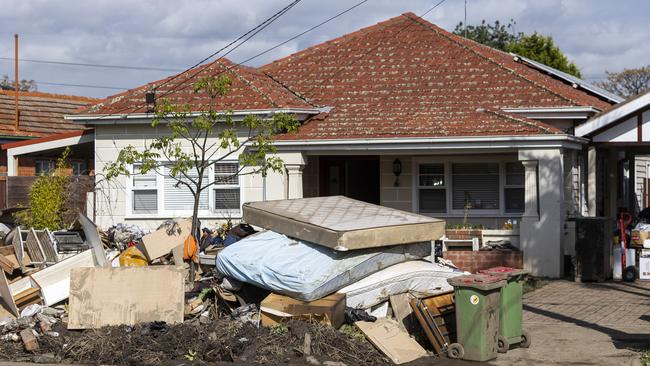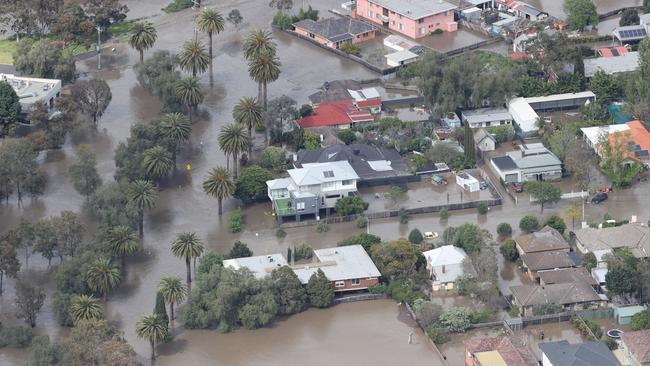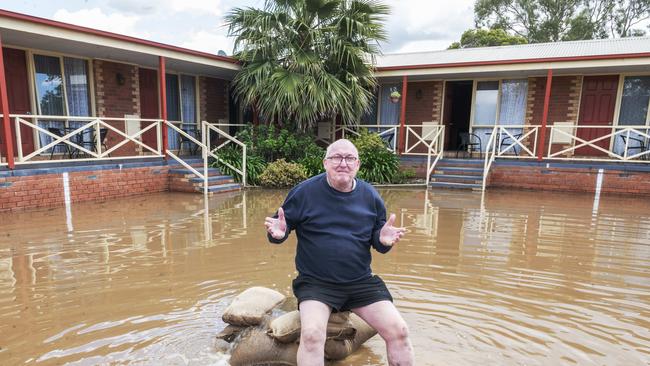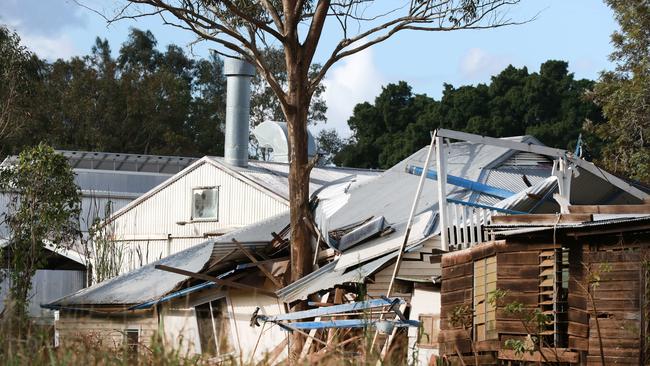Nature’s trickle-down effect will keep costing us billions in a deeply uncertain new world
Disasters smashing large parts of the country are a toxic mix of nature and man-made own goals. But don’t think you’re not affected; they are costing you, too.

Lismore Mayor Steve Krieg is 1500km from the Victorian floods that have brought loss of life, property destruction and uncertainty to hundreds of thousands of people in the past week.
Having survived the worst of the northern NSW floods in 2022 and 2017, Krieg warns the impact of a large-scale natural disaster will be profound for those on the ground.
“My best advice is make sure you look after yourself first and foremost,” he says.
Krieg sought trauma counselling after the Northern Rivers region was smashed by floods, stressing that the cost of these disasters can be financial, emotional and material.
The Victorian floods, which roared through Melbourne’s inner northwest late last week and dumped on thousands of square kilometres in the heart of Australia’s $22bn food bowl, will play out for weeks, fuelling the national cost-of-living crisis and creating challenges for the country’s biggest river system.
Much of the run-off from the Murray-Darling Basin is expected to take several weeks to find its way to Goolwa in South Australia and into the Southern Ocean, on its way flooding more land and reigniting the debate about the role of climate and official inertia when confronting what most experts believe is a deeply uncertain new world.

Many of the factors facing the three tiers of government are shared with the great disasters of the past century, notably the Queensland/Brisbane floods of 2010-11 and the Black Saturday bushfires in Victoria in 2009.
The worst-affected areas are often the result of people buying the cheapest land in the most vulnerable disaster areas, mixed with man’s interference with the environment and nature’s ultimate final say.
Development plays a huge role in the national flooding disaster story. Concrete, houses, fences and – in the case of Australia’s most famous racetrack – building flood mitigation with potentially profound downstream and upstream effects all help influence the way water flows in 2022.
Just as crucial a role as primary producers play when they gather and divert water as they try to make a living in the world’s driest continent or tree-changers who build houses in thick bush that no local fire brigade can defend.
In the case of Lismore – the contemporary test case for flood-affected urban landscapes – Krieg is adamant that communities should ignore the white noise of the culture wars.
“I think we need to stick hard with what the experts recommend,’’ he said.
Insurance Council of Australia chief executive officer Andrew Hall is leading an organisation that is still mopping up after the February rain bomb that struck from Maryborough in Queensland, all the way to Sydney, leaving more than $5bn in insured losses, making it the second-costliest extreme weather event in Australian history.
The still unfolding Victorian crisis is likely to cost the economy, insurers and flood victims billions as well, leading to further cost-of-living challenges and food shortages.
“Extreme weather events are what define Australia,” Hall says, with flood, fire and cyclones considered the holy trinity in the disaster game.
The 1974 Cyclone Tracy disaster in Darwin, which killed 71 and all but wrecked the city, led to significantly higher building standards in the northern capital. After the Black Saturday fires, where 173 people died and 2000 properties were razed, there have been gains with new building standards and better early warning systems.

But Hall warns that with floods, there is a patchwork official response, with houses still being built in high flood zone areas as surging house prices drive up demand for cheaper land.
“And the developments are still happening today,’’ he laments.
Water, as the saying goes, finds its own level. Scores of rivers and creeks have broken their banks in the past 10 days in Victoria, fuelled by up to 250mm (10 inches for old-timers) of rain dumped in quick time, on the back of a La Nina in the tropical Pacific, which is expected to continue into early next year.
In an ideal world, insurers and governments would love to be able to move many towns and urban developments holus-bolus to other areas, or at least institute a broad buyback scheme for exposed assets.
Professor Rory Nathan, a hydrology expert from the University of Melbourne, warns that the risk of weather-induced disasters will continue to rise in both frequency and intensity, meaning things may worsen over time. Nathan says towns such as Grantham, in Queensland’s Lockyer Valley, which was wiped out by a wall of water in 2011, is one of many victims of history.
He says measures can be taken to make houses in flood areas more adaptable to the conditions, with basic items such as power points and valuables located higher in buildings, and more practical floor coverings that can be removed quickly.
“It’s the legacy problems that have really created a problem for us. Councils encourage development. (The) easiest place to put it is on flood plains,” Nathan says.
When the rain fell in vast quantities in Melbourne’s Maribyrnong River catchment last week, it was no great surprise it flooded, nor was it a great surprise that hundreds of houses were inundated, most of them on the flood plain or in the lower-lying areas on the flood plain.
Victorian Premier Daniel Andrews was in overdrive trying to manage the flood response, having spent part of his childhood in flood-prone northeastern Victoria, energised by the looming November 26 state election.
Andrews well knows the last thing country people are looking for is a debate about climate change, but he has already flagged major reforms could follow the latest downpour.
“When it comes to issues of planning policy, that’s a matter for the local councils by and large,’’ he said. “Whether it’s levees or flood planning, there will be a proper look at the whole event once it’s finished. There will be learnings, of course there are.’’
The frustration for many in flood-affected areas is that the disasters smashing large parts of the country are a toxic mix of nature and man-made own goals.
Since white settlement, recorded history has shown that the country floods and burns with monotonous regularity. More specifically, that floods and fires often go back to the same places.
In Echuca, 230km north of Melbourne, there are three main rivers bordering or near the township. The Murray River to the north, the Campaspe River to the west and the Goulburn River, which joins the Murray about 15km upstream.

There have been at least 16 significant floods since 1867 in the local shire, four floods occurring between September 2010 and February 2011. There is no surprise Echuca is in the midst of another flooding event. Perhaps the only surprise would be that anyone is surprised.
The consequences of rolling disasters are economic and social. A report this year for the ICA found Australian households will be paying an average of more than $2500 every year for extreme weather events, up almost 200 per cent from the 10-year rolling average of $888 per household.
Virtually all the assumptions made by the three tiers of government factor in climate modelling when considering long-term risks, which means regardless of views on the science, policy will be heavily influenced by it.
All change involving infrastructure projects costs money. Emergency Management Minister Murray Watt last month outlined plans for an annual investment of $200m a year to invest in mitigation projects such as flood levees, cyclone shelters, fire breaks and evacuation centres.
“Over three years, Scott Morrison’s emergency response fund didn’t complete a single mitigation project or release a cent in recovery funding, while earning the former government over $800m in interest. This left us dangerously unprepared for increasing natural disasters,’’ he said at the time. “The Albanese government won’t repeat the mistakes of the previous government.”
It’s a big call by federal Labor. As successive state and federal governments have found, it costs an enormous amount to rebuild after disasters, and arguably much more to stop future events from causing intolerable damage.
The practical realities are that $200m would be swallowed up overnight amid the tens of thousands of projects needed to make a big impact on future events such as floods. More than 12 years after the Black Saturday fire disaster, for example, very few community fire refuges were ever built. Despite all the deaths and the royal commission findings.
It’s one thing to want to prevent future disasters, quite another to make that goal a reality.


To join the conversation, please log in. Don't have an account? Register
Join the conversation, you are commenting as Logout